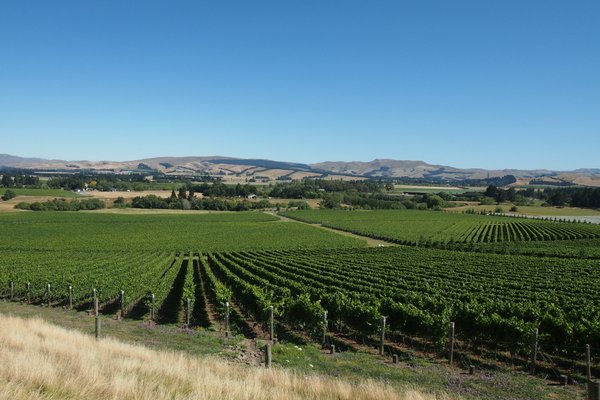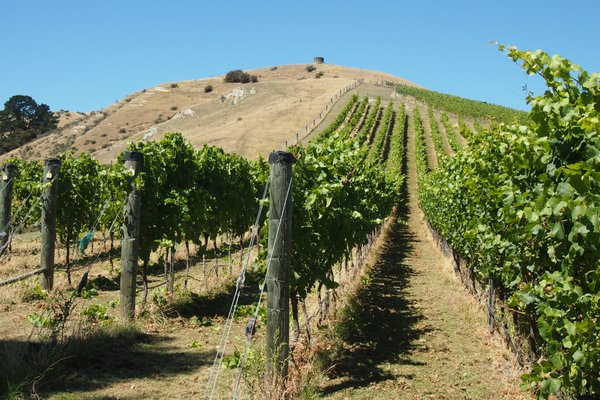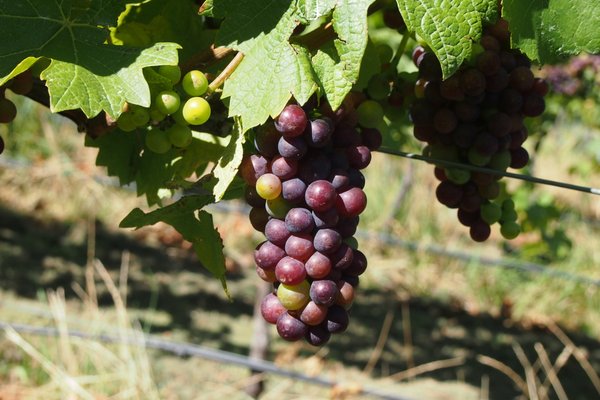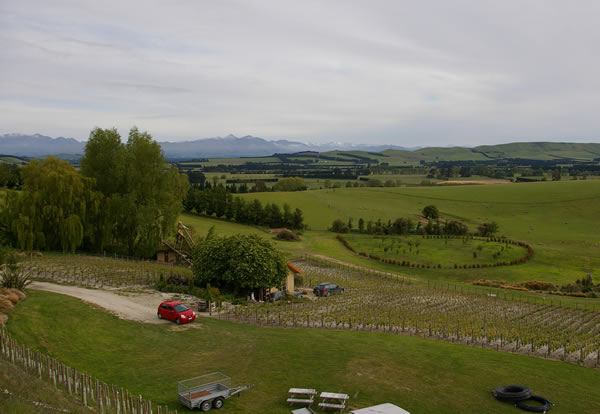|
North Canterbury and the Waipara Valley
A series on one of New Zealand's most interesting
wine regions: part 1, a historical perspective

North Canterbury is the region that includes the Waipara Valley, and
also the vineyards that are part of its more recent westward
expansion to Waikari. It’s just a short drive north from
Christchurch. This is now one of New Zealand’s most exciting regions
for Pinot Noir and Riesling, but as with all the south island
regions, its history is relatively recent.
The roots of the modern era of North Canterbury date back to the
1970s, and to Lincoln College (now Lincoln University), a short
distance southwest of Christchurch. And there’s one individual at
the heart of the development of Canterbury as a wine region: Danny
Schuster.
Schuster came to New Zealand in 1973. Originally from Prague, with a
German father and Austrian mother, Schuster had trained in
viticulture and enology in Czechoslovakia. He’d visited New Zealand
after working a couple of vintages at Seppelts in Australia, and he
met Dr Paul Mulcock of Lincoln College and Bill Turner, president of
the Canterbury fruit growers’ association. They were looking for
someone to work on a project on cider fermentations, and hired
Schuster. While at Lincoln, Schuster was to meet Dr David Jackson, a
fruit scientist, and together they began working to assess the
suitability of Canterbury for wine production. Remember, at this
time the South Island wasn’t making wine. Central Otago had no
vines, and the first vines had only just been planted in
Marlborough.
After a bit of a struggle, Jackson got a $750
grant to investigate the idea of grape growing in Canterbury, and
trial plantings commenced at Lincoln. But the first season of these
trials, 1975/6, proved to be a difficult one, with just 630 growing
degree days (GDDs) as opposed to the 10 year rolling average of 973.
But they continued, and a 1978 report details 40 wine grape
varieties and 20 table grape varieties, with microvinifications
carried out by Jackson’s technician, Graeme Steans. A tasting panel
was convened with 15 members, of which at least 10 met at any one
time, to assess the quality of these trial wines.

The initial success of these trials led Steans to buy land in
Kaituna Valley in the Banks Peninsula, where he planted an acre of
vines in 1977. Pinot Noir was a major variety in Steans’ vineyard,
and these 1977 plantings are now likely to be
New Zealand’s oldest Pinot Noir vines.
Bill Turner, who’d been involved in hiring Schuster a few years
earlier, was another pioneer, and his story is an interesting one.
He had an orchard called Lochbuie in
Belfast, on the outskirts of Christchurch, from which he made cider.
He decided to plant 5 acres of grapes taken from the Lincoln
experimental plantings. He got to know a young Irish entrepreneur
called Ernie Hunter, who had established Canterbury’s first wine
bar, and they went into partnership together. In 1979 Ernie bought a
26 hectare block in Rapaura, Marlborough, at $3000 per hectare,
which included a small homestead. Hunter had no cash, so the
arrangement was that he paid rent on the property and then paid in
instalments, which were due in 1982 and
1985. The plan was to make the wine down in Christchurch at Lochbuie.
In 1981, just before the first harvest, Hunter held a party at his
Rapaura homestead, and one of the guests was a young German
winemaker called Almuth Lorenz. He hired her, and in 1982 she made
the first Hunter wine in a very primitive winery improvised out of
beer tanks at Lochbuie. This was a blend of Hunter’s grapes with
Turner’s Canterbury grapes, and the resulting
1982 Müller Thurgau dry won three bronze and three silver medals at
the National Wine Show.
Brothers Robin and Norman Mundy, at Coutts
Island, also planted vines. They’d previously grown potatoes, but a
nematode infestation knocked out their production. They went to
Lincoln to see what else they could grow—blackcurrants were the hot
favourite—but they decided to try wine grapes. With advice from
Schuster, they planted 10 acres in 1978, and by 1981 when they made
their first wine under
the brand name of St Helena they had 31 hectares in the
ground. With Schuster as winemaker the second vintage of the St
Helena Pinot Noir, the 1982, won gold medal at the Air New Zealand
Wine Competition, which helped put the
region on the map. This was only the second Pinot Noir from New
Zealand to have won a gold medal. Interestingly, this wine also
contained a ton of grapes from Graeme Steans’ Kaituna Hills
vineyard.
It’s here we need to mention what was known as the ‘Doctors’ Patch’,
a one acre vineyard on the south side of Christchurch on the foot of
the Port Hills. This introduces an important figure into our story:
Dr Ivan Donaldson. He was one of a group of three doctors, two
dentists, two engineers and a lawyer who wanted to plant some vines
for some home winemaking. The vines were planted in 1976 and the
project continued for 22 years. Donaldson made the wine in his
garage for about 15 years. In 1984 he started looking at buying a
piece of land in the Waipara Valley, where it was warmer because of
a coastal hill range providing protection from the easterly winds.
So Ivan and his wife Christine looked at every property coming on
the market. They were looking for free draining soil. They didn’t
find anything suitable so they ended up approaching the farmer who
owned the site Pegasus Bay is currently located on. They bought the
property here in 1985. They’d already planted a nursery at Danny
Schuster’s place in 1985, and from this they then planted 50 acres
of vines on their own roots in 1986. A little bit of wine was made
in 1990, but the first Pegasus Bay release was the 1991, made in
their Christchurch garage. Matt Donaldson, Ivan’s son, processed 18
tons at the winery in 1992 after he returned from wine school.

But the first plantings in the Waipara Valley
itself were made by John McCaskey, who had a 400 hectare farm
with poor stony soils on the Weka plains. He first experimented with
grapes in the mid-1960s, but these hybrid vines he planted were
washed away by a flash flood. He tried again in 1981, with 4
hectares planted with vines that he’d obtained from Tim Finn in
Nelson. 1985 was the first experimental vintage, made by American
Stever Harber. McCaskey subsequently subdivided his land for other
vineyard projects, and now there are 19 different vineyards planted
on his original farm.
In 1982 there were four more vineyard projects: Bruce and Jull
Moore, Derek Quigley, the Glenray partnership and John Corbett.
Corbett was to establish Waipara Riesling on the New Zealand wine
map, winning gold medals with his 1986, 1988 and 1989 vintages. And
in 1986 Danny Schuster started his own operation
in the valley, planting his Omihi Hills vineyard.

In recent years, the quest for special terroirs has led to the
westwards expansion of North Canterbury region through the Weka
pass, into the foothills of the southern alps at Waikari and Pyramid
Valley. In 1997 Bell Hill established a close-planted vineyards on
an old limestone quarry, and Pyramid Valley was planted in 2000 on
clay and limestone soils. These new ventures have been significant,
because they have resulted in some
stunning wines.
NORTH
CANTERBURY WINE REGION
 A historical perspective A historical perspective
 Physical features Physical features
 Alan
McCorkindale Alan
McCorkindale
 Black Estate Black Estate
 Bellbird
Spring Bellbird
Spring
 Pegasus
Bay Pegasus
Bay
 Mountford Mountford
 Bell
Hill Bell
Hill
 Pyramid
Valley Pyramid
Valley
 Fancrest Fancrest
 Bishops
Head Bishops
Head
 Casa
Leopardi Casa
Leopardi
 Greystone Greystone
 Mount
Brown Mount
Brown
 Muddy
Water Muddy
Water
 Tongue
in Groove Tongue
in Groove
 Terrace
Edge Terrace
Edge
 Waipara
Springs Waipara
Springs
 Waipara
West Waipara
West
 Waipara
Hills Waipara
Hills
Find these wines with wine-searcher.com
Back
to top
|

